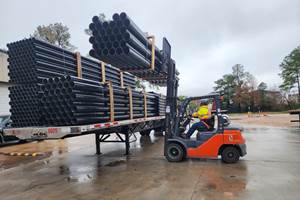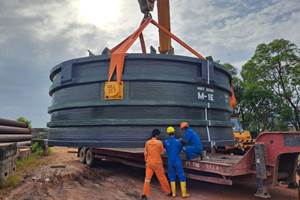Composites reinvent infrastructure
Celebrating National Composites Week, CW shares ways in which composites continue to evolve the way we approach infrastructure projects.

Source | NREL; Creative Composites Group; Sireg Geotech; RPC Technologies
In the realm of infrastructure development, the unique properties of composite materials — such as durability, lightweight and environmental sustainability — make them an increasingly attractive option for modern construction.
One of the most significant advantages of composite materials in infrastructure is their exceptional durability. Traditional materials like steel and concrete are prone to corrosion and degradation over time, particularly in harsh environments. Composites, on the other hand, are highly resistant to corrosion, chemicals, and weathering. This resistance significantly extends the lifespan of structures, reducing the need for frequent maintenance and repairs.
The lightweight nature of composite materials translates into numerous advantages for infrastructure applications. Despite being significantly lighter than traditional materials, composites can offer comparable or even superior strength. This weight-to-strength ratio is particularly beneficial in infrastructure projects where reducing weight can lead to cost savings in transportation, installation and support structures. For example, composite materials are being used in the construction of modular buildings, where their lightweight properties facilitate easier transportation and assembly.
While the initial cost of composite materials may be higher than that of traditional materials, there is evidence for their long-term economic benefits. The reduced need for maintenance, longer lifespan, and potential for modular construction contribute to significant cost savings over time. For instance, in the case of bridge construction, the use of composites can lead to reduced maintenance costs and extended service life, resulting in a lower total cost of ownership.
For National Composites Week, CW is providing daily roundups starring some of the prominent end markets in which composite materials greatly contribute. Each roundup comprises relevant published content to explore and read.
Note: Below covers only 2023-2024 articles for these topics. For other related content (including news and products), please visit CW’s markets page.
Wind energy
CW Talks discusses Ford Motor Company’s involvement with the EMPHASIZING project, a UK consortium working to develop a material from recycled glass fiber with mechanical properties superior to virgin glass.
Research enables successful automation in post-molding manufacturing operations, which could lead to more competitive U.S.-based blade manufacturing.
Utility
EasyStreet Systems is working with Exel Composites to develop and certify pull-wound fiberglass utility poles aimed at durable, lightweight poles for 5G small cell systems.
Metromont’s C-GRID-reinforced insulated precast concrete’s high strength, durability, light weight and ease of installation improve data center performance, construction time and sustainability.
Texas-based Champion Fiberglass, a five-time CW Top Shops honoree, expands its success in the fiberglass composite conduit market into new applications and products, looking toward future automation and sustainability initiatives.
About National Composites Week
The goal of National Composites Week (NCW) is to celebrate and bring attention to the ways that composite materials and composites manufacturing contribute to the products and structures that shape the American manufacturing landscape today.
NCW takes place each year in the final week of August and celebrates a specific theme.
The 2024 theme was Composites Reinvent the World. on LinkedIn and read more from the CW editorial team:
Related Content
Sustainable Infrastructure Systems creates fiber-reinforced post-consumer plastic structural panels
Australian composites manufacturer offers a scalable building solution, already established in a pedestrian bridge application, to tackle unprocessed soft plastics waste.
Read MoreComposite SIPs for more affordable, efficient and sustainable buildings
LiteSIP panels and modules enable framing in days, cutting structural labor and total cost by up to 70% and 30%, respectively, while increasing energy efficiency and durability.
Read MoreFiberglass conduit manufacturer grows into new products, infrastructure applications
Texas-based Champion Fiberglass, a five-time CW Top Shops honoree, expands its success in the fiberglass composite conduit market into new applications and products, looking toward future automation and sustainability initiatives.
Read MoreComposites end markets: Infrastructure and construction (2024)
Composites are increasingly used in applications like building facades, bridges, utility poles, wastewater treatment pipes, repair solutions and more.
Read MoreRead Next
Scaling up, optimizing the flax fiber composite camper
Greenlander’s Sherpa RV cab, which is largely constructed from flax fiber/bio-epoxy sandwich panels, nears commercial production readiness and next-generation scale-up.
Read MoreCutting 100 pounds, certification time for the X-59 nose cone
Swift Engineering used HyperX software to remove 100 pounds from 38-foot graphite/epoxy cored nose cone for X-59 supersonic aircraft.
Read MoreCeramic matrix composites: Faster, cheaper, higher temperature
New players proliferate, increasing CMC materials and manufacturing capacity, novel processes and automation to meet demand for higher part volumes and performance.
Read More












